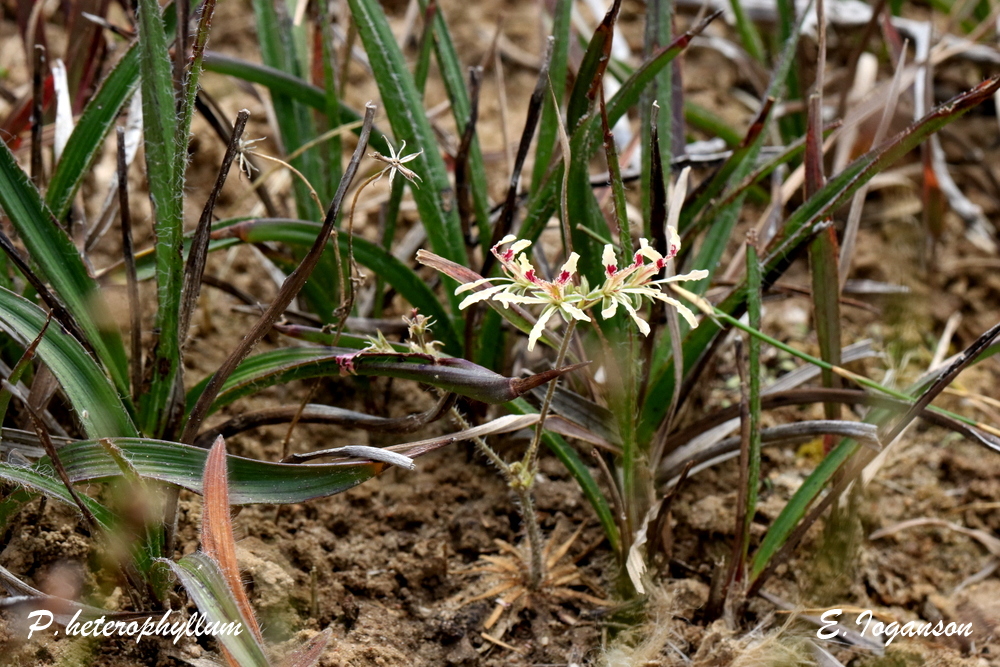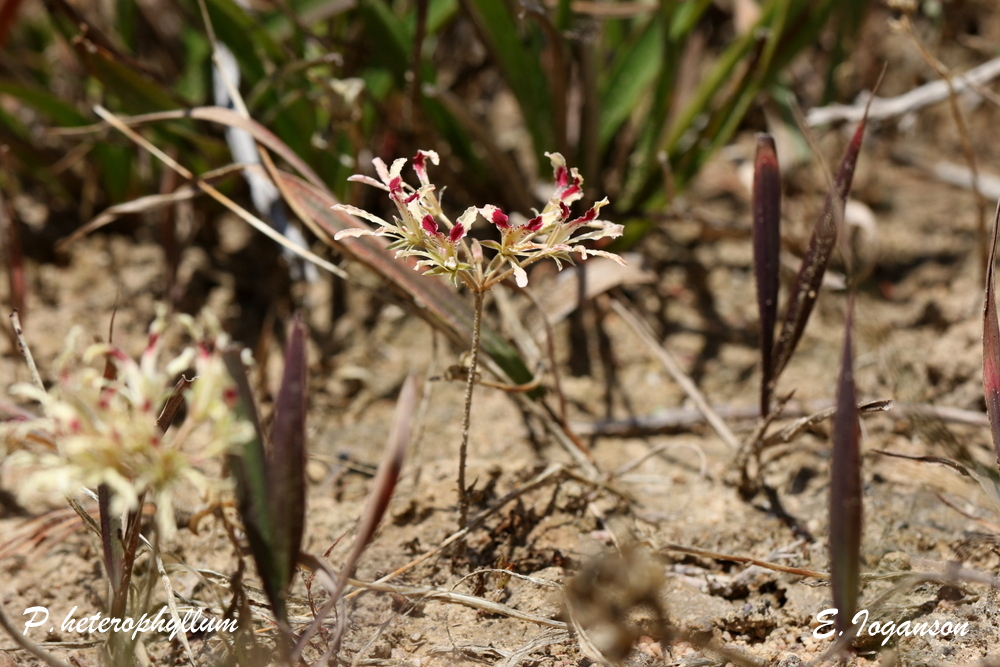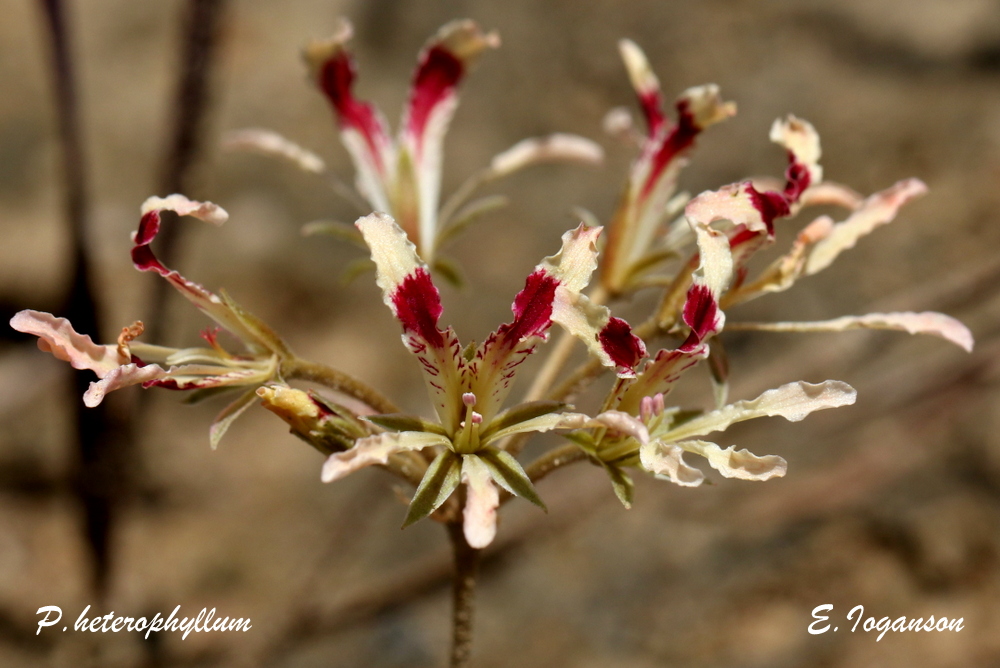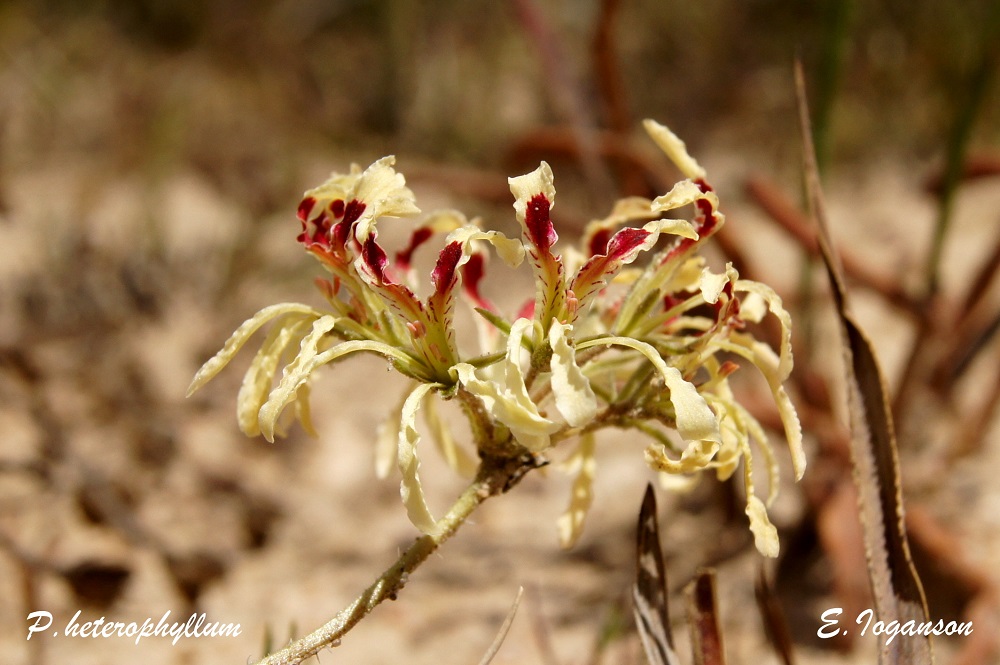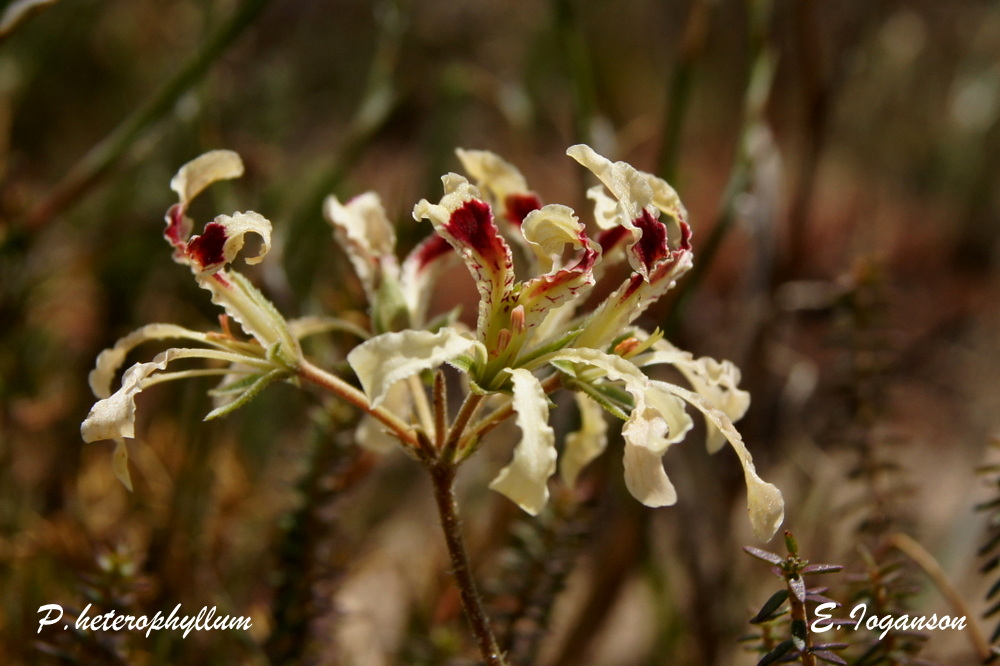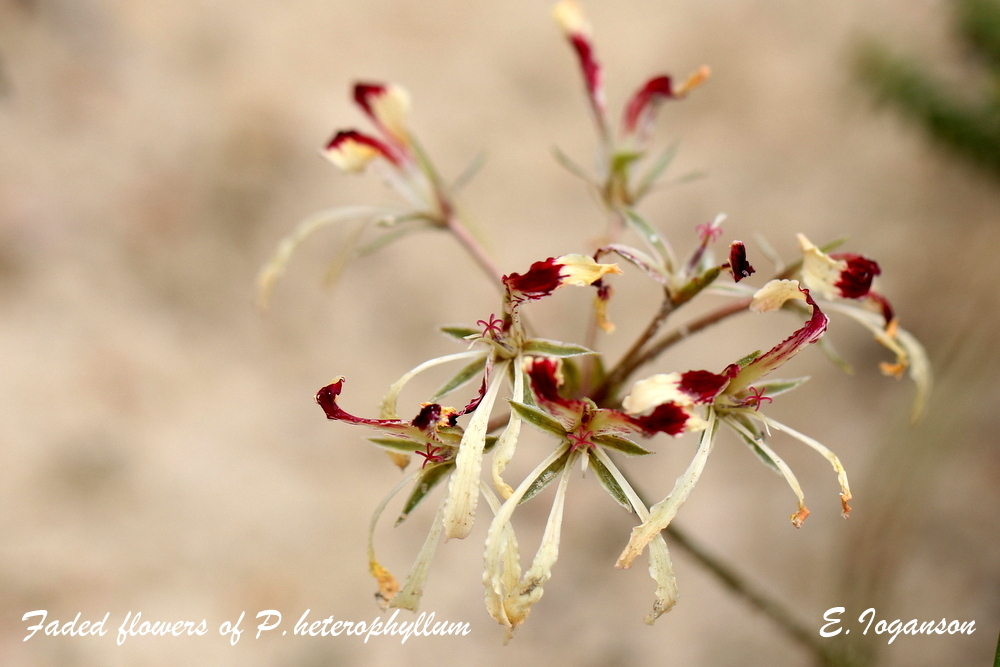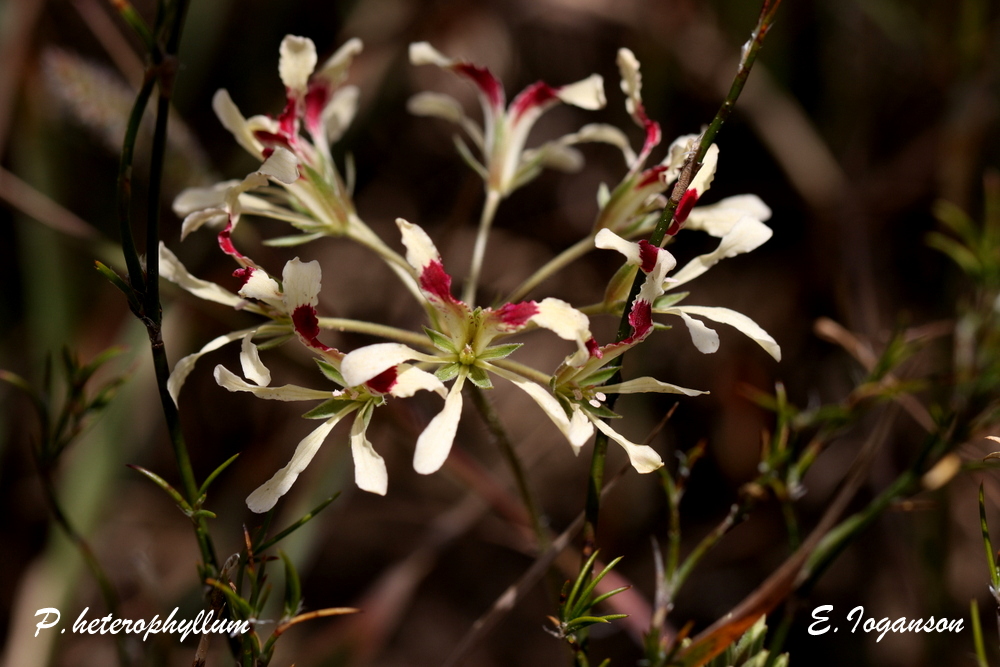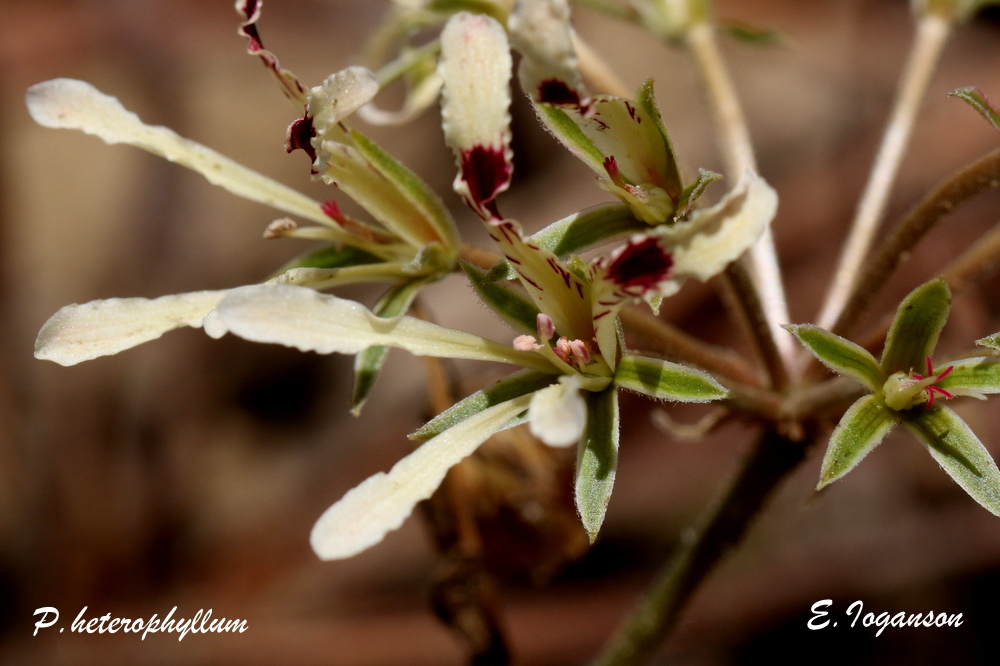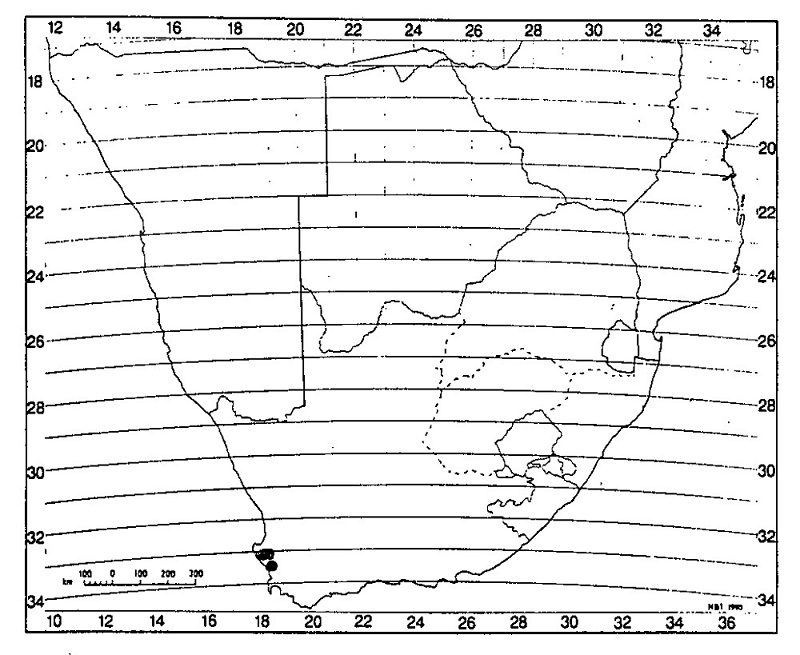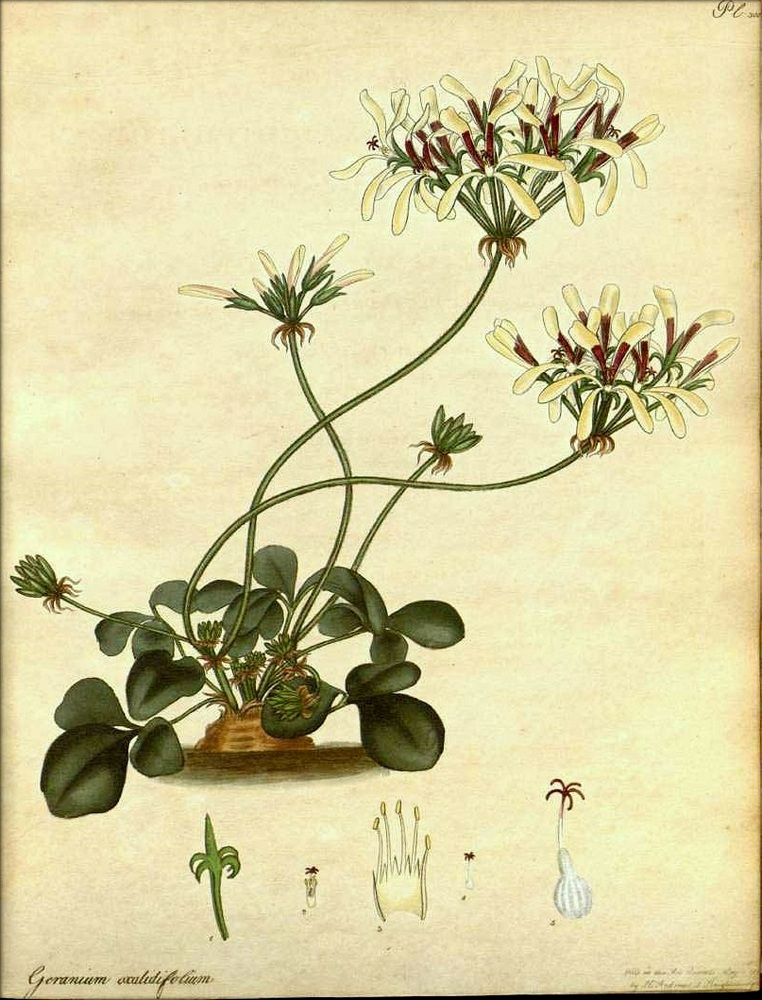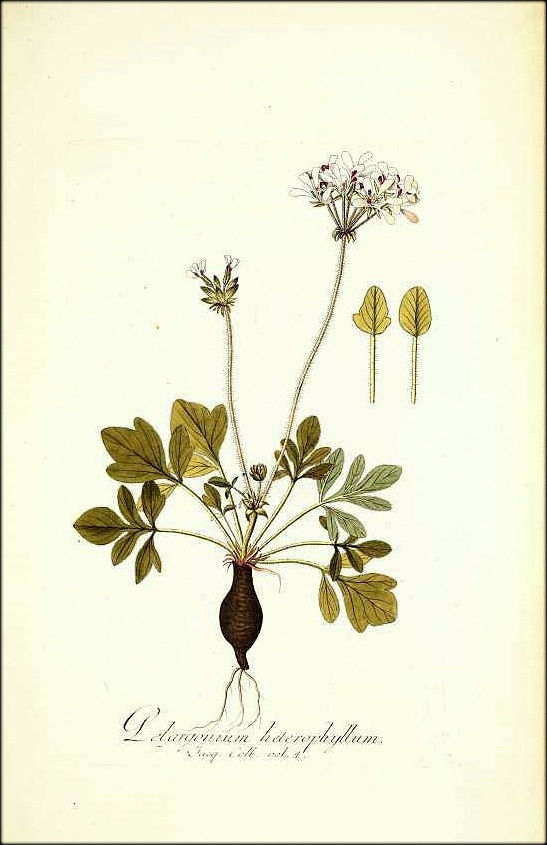P. heterophyllum
РусскийPelargonium heterophyllum Jacq., Icon. Pl. Rar. 3: t. 516 (1794)
genus: Pelargonium L'Héritier
subgenus: Pelargonium L'Héritier
section: Hoarea (Sweet) De Candolle
syn. (8): Dimacria oxalidifolia (Andrews) Sweet; Geraniospermum heterophyllum (Jacq.) Kuntze; Geraniospermum oxalidifolium (Pers.) Kuntze; Geranium oxalidifolium Andrews; Geranium pilosum Cav.; Hoarea heterophylla Eckl. & Zeyh.; Pelargonium cavanillesii R. Knuth; Pelargonium oxalidifolium (Andr.) Pers.
The specific epithet heterophyllumrefers to the variation that occurs in the leaf form.
A geophyte 70—170 mm tall when in flower. Tuber:a turnip-shaped root 10—25 mm long and 12—25 mm in diameter. Leaves: simple, trilobate or trifoliolate, bright green, petiolate; lamina (or main pinna) ovate or trullate, base cuneate, apex obtuse, margin entire, 8—25 x 6—25 mm; small lateral pinnae ovate, 8—10 x 5—7 mm, adaxially glabrous or covered with short glandular hairs, abaxially glabrous or setose along the veins, margins with short appressed clavate bristle-like hairs; petiole 4—30 mm long and 1—3 mm in diameter, prostrate, covered with short glandular hairs interspersed with bristles or clavate hairs; stipules subulate or lanceolate, adnate to petioles for less than one third of their length, 4—10 mm long and 2—3 mm wide, ciliate. Inflorescence:scape 10—50 mm long and 1,5—2 mm in diameter, branched, bearing 2—6(-8) pseudo-umbellets with 4—9(-11) flowers each; peduncles 40—150 mm long, 1—1,5 mm in diameter, covered with short glandular hairs interspersed with patent bristles; bracts narrowly triangular, 2—5 mm long, 1—2 mm wide, adaxially hirsute, abaxially setose with distally appressed bristles. Pedicelca. 0,5 mm long. Hypanthium: 9—15 mm long, pale reddish-brown, indumentum as on peduncle and sometimes with appressed curly hairs. Sepals 5, lanceolate, apices acute, 6—8 mm long, 1—2,5 mm wide, patent, green, abaxially covered with,short glandular hairs interspersed with short patent bristles. Petals 5, white or cream-coloured with undulate margins, claws patent during anthesis forming a floral sheath; posterior two with a prominent black blotch in the centre, ligulate, laterally curved, bases cuneate, apices rounded or emarginate, laterally recurved, 17—22 x 2,5—4,5 mm; anterior three narrowly spathulate, bases attenuate, apices roundqd, 15—20,5 x 2—3,5 mm. Stamens:staminal column 1—2 mm long, white; perfect stamens 5, concealed in floral sheath, posterior one 1,5—3 mm long, lateral two 2,5—5,5 mm long, curved upwards, anterior two 4,5—7 mm long, curved upwards, white; staminodes 1,5—2,5 mm long; anthers pale pink, 1,5—2 mm long, pollen almost white. Gynoecium:ovary 2—4 mm long; style 0,5—1,5 mm long, pink; stigma branches 0,5—1,5 mm long, pink.
Diagnostic features and affinities
P. heterophyllum is a small attractive species with white or cream-coloured flowers with large prominent wine-red blotches in the centre of the posterior petals. The claws of the petals form a sheath in which the stamens are concealed, and the apices of the posterior petals are laterally recurved. The posterior stamen is usually much shorter than the lateral and anterior ones. This structure of the androecium is similar to that of P. tenellum and P. trifoliolatum.The small simple or trifoliolate prostrate leaves with appressed bristles along the margins, are similar to that of P. tenellum and P. chelidonium. However, the floral structure of P. chelidonium differs from that of P. heterophyllum and P. tenellum.
Pelargonium heterophyllum in habitat. Next to Malmesbury, Western cape, South Africa. Photos by E. Ioganson
Geographical distribution and ecology
P. heterophyllum is known from a small distribution area in the vicinity of Darling about 60 km north of Cape Town. Small populations of this species are also found near Malmesbury. This area receives an annual rainfall of 300—400 mm, which occurs mainly during the winter months. P. heterophyllum occurs in renosterveld in stony sand, on flats or lower hillsides or in marginal coastal fynbos in gravel.
It flowers in October and November, after the leaves have died.
Geographical distribution of Pelargonium heterophyllum
Pelargonium heterophyllum has a status of Critically Endangered (CR) in The Red List of South African Plants and has a very limited distribution range. This species is probably rarest and most endangered of South Africa’s plants at present. It may become extinct in the wild if the habitat degradation and destruction by crop cultivation will be continuing.
Pelargonium heterophyllum in habitat. Next to Malmesbury, Western Сape, South Africa. Video by E. Ioganson


Pelargonium heterophyllum Jacq. N.J. von Jacquin, Icones plantarum rariorum, vol. 3: t. 516 (1786-1793)

Pelargonium heterophyllum as Geranium oxalidifolium Andrews. The botanist’s repository, vol. 5: t. 300 (1803-1804) [H.C. Andrews]


References
- Craib, C. 2001. Geophytic pelargoniums field and cultivation studies of Pelargonium section Hoarea. Umdaus Press, Hatfield, Pretoria.
- Cunliff, J. & Teicher, U. 2005. Botanical names and their meanings.
- Gibby, M., Hinnah, S., Marais, E.M. & Albers, F.1996. Cytological variation and evolution within Pelargonium section Hoarea (Geraniaceae). Plant Systematics and Evolution. Vol 23 (1): 111–142.
- Goldblatt, P. & Manning, J. 2000. Cape Plants. A conspectus of the Cape flora of South Africa. Strelitzia 9. National Botanical Institute, Pretoria & Missouri Botanical Garden, Missouri.
- Helme, N.A. & Raimondo, D. 2007. Pelargonium heterophyllum Jacq. National Assessment: Red List of South African plants version 2017.1. Accessed on 2018/11/27.
- Marais, E.M. 1994. Taxonomic studies in Pelargonium, section Hoarea (Geraniaceae). Ph.D. Thesis, University of Stellenbosch, Stellenbosch.
- http://pza.sanbi.org/pelargonium-heterophyllum

























